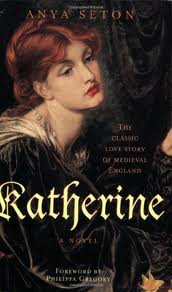Katherine by Anya Seaton
Reviewed by Jennifer

Ratings Explanation
Language: Some common swear words. There are numerous curses and oaths using the names of God and Jesus Christ, like “God’s bones” and “by Christ’s blood”. “Jesu” also used often as an exclamation.
Violence: A jousting tournament and sword fighting are described. Hugh slaps Katherine. A character is killed with poison. The serfs riot in London, killing and beating merchants and members of the court. Severed heads are displayed on pikes. They also burn and destroy buildings. One particularly graphic description of a man’s head being split open by means of a sword. Prisoners are held in shackles and the stocks. Some descriptions of war.
Sexual Content: There is some talk of Katherine and Hugh’s wedding night and women losing their “maidenhead”. This book details court life of the 14th century in which royals having paramours is expected and accepted. There are very few actual descriptions of sexual encounters, but many in the court are having affairs. Katherine and John, although they truly love each other, are not married and have four children together. Drunken and scantily clad people dance and grope each other. “Bedsport” is mentioned fairly often. Phrases alluding to sex, such as, “They had lain together hot with passion” are frequent throughout the book.
Adult Themes: Lady Nichola suffers from mental illness and commits suicide. Adultery and its consequences, especially for the illegitimate children born from it.
Synopsis
Katherine de Roet is orphaned at a young age when her recently knighted father dies in the King’s service. The Queen takes an interest in Katherine and her sister and sends Katherine to be raised in a convent while taking on her sister, Phillipa, as a serving girl in the royal court. Katherine is eventually brought to court with the intention of finding her a husband who will accept a wife with no dowry. Katherine is enamored of the sparkling Plantagenet family and dreams of marrying a brave knight. So when Sir Hugh Swynford asks for her hand, everyone tells her what an honor it is, but Katherine has no love for this awkward and rough knight and tries to avoid the union. Eventually accepting her fate, Katherine and Hugh marry, but Katherine holds herself apart, harboring a secret love for John of Gaunt, the King’s son and Duke of Lancaster who is married to the kind and lovely Duchess Blanche.
After a turn of events, John and Katherine are free to realize their love for each other and enjoy many happy, though tumultuous years together, including the addition of four children to their union. Although John is wed to a Castillian princess, Katherine enjoys the luxuries of the royal family. When angry serfs mob London, the royals are threatened, but through lies and brute force the rebellion is quashed. These frightening events bring Katherine to a realization of her sinful situation and she decides it is time to make penance. She recognizes that her decisions over the years have gravely affected the children she has borne with John, and in her mother’s heart she knows she must do all she can to make things right. Her journey to spiritual peace leads Katherine to a much different life than the one she lived in the opulent royal court, but as Katherine works and prays she is able to forgive herself and find happiness with her children.
Katherine is the story of the well documented love affair between John and Katherine, which union eventually produced the royal line of England.
I thoroughly enjoyed Katherine. Anya Setons’s writing transported me into the physical, spiritual, and cultural world of 14th century England. A world where the royalty exercises complete dominion over the commoners, exploiting their labor to finance their extravagant lifestyle and their wars, but also a romantic world of jousting tournaments, honor and chivalry.
Religion is a particularly interesting aspect of the book and the role it played, or didn’t, in the lives of the characters. Katherine begins the story a devout believer, but as her lifestyle conflicts with her beliefs, she abandons her religion in order to rationalize her actions. It is gratifying in the end that she is able to find peace in both her physical and spiritual life.
Love was not expected within the bonds of marriage as “marriage was a commercial transaction, a peacetime weapon for the acquisition of new lands and the extension of power.” This makes John and Katherine’s love even more sweet because “she had brought him no wealth, no power, no hope of foreign thrones.” She only brought him herself. And that was enough. Truly a love story for the ages.
This book provides an opportunity for conversations about the expectations of marriage then and now. How our actions, no matter what they are, affect other people and the position and role of women throughout history. During this time period, most people, both wealthy and poor, believed that God had ordained the order of things. That those of royal birth were chosen of God and those who served them were meant to do so, without question or rebellion. How do our beliefs about class or station differ today?











